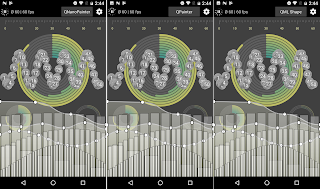Using QNanoPainter without QtQuick (pure C++)
Originally, QNanoPainter library was implemented to fulfill the needs of easy to use but performant custom OpenGL QQuickItems. For the needs, Qt Quick Scene graph QSG* classes felt a bit too low-level to be productive, while QQuickPaintedItem was slightly lacking in performance and rendering quality on mobile hardware. For more details, please read this QNanoPainter introduction blog post.
I like (OK, love) Qt Quick & QML and have used them successfully in many different projects. On desktop, mobile and embedded software. A lot. But Qt Quick doesn't suit all situations or it is not always required. As explained in this Qt blog post, Qt 5.12 improves Qt Quick performance and memory usage. But naturally there still is some memory and startup time additions coming from Qt Quick engine.
Fear not, QNanoPainter can be used also without Qt Quick. Available entry points are:
Also made applications to exit automatically with timer after running for 2 seconds, to let the memory consumption stabilize. Measuring was done using MTuner memory profiler for Windows. Using freshly released 5.12.2, MTuner memory usage graphs look like this:
So QNanoQuickItem based version is using most memory, peaking at 28.9MB. QNanoWidget comes next with 23.3MB peak usage. And slimmest, as expected, is QNanoWindow app with 19.0MB.
Note that all of these use normal MSVC2015 Qt 5.12.2 from installer and release builds of applications, without extra compiler options or anything. With those and Qt Lite it would be possible to build more streamlined versions especially for QNanoWindow which doesn't depend on other Qt modules than Qt Core & GUI. Further optimizations and testing is left as an exercise for readers and the ones needing it :)
In conclusion: If you are working on embedded device with OpenGL ES 2 / 3 capable GPU, concerned of flash & RAM usage and require relatively simple user interface, I would encourage to check out QNanoWindow. You get hardware accelerated nicely antialiased graphics, in pure C++.
I like (OK, love) Qt Quick & QML and have used them successfully in many different projects. On desktop, mobile and embedded software. A lot. But Qt Quick doesn't suit all situations or it is not always required. As explained in this Qt blog post, Qt 5.12 improves Qt Quick performance and memory usage. But naturally there still is some memory and startup time additions coming from Qt Quick engine.
Fear not, QNanoPainter can be used also without Qt Quick. Available entry points are:
- QNanoQuickItem & QNanoQuickItemPainter - This is where it all started, use these to implement your QQuickItems.
- QNanoWidget - Based on QOpenGLWidget so can be used for widget based applications. Used similarly to QWidget and just contains QNanoPainter API for painting instead of QPainter. As QNanoPainter is OpenGL (ES) powered, in some cases this can substitute also QGLWidget based components.
- QNanoWindow - Based on QOpenGLWindow / QWindow so very lightweight. Optimal for embedded software which would only need a single QNanoWindow for the whole UI.
Also made applications to exit automatically with timer after running for 2 seconds, to let the memory consumption stabilize. Measuring was done using MTuner memory profiler for Windows. Using freshly released 5.12.2, MTuner memory usage graphs look like this:
So QNanoQuickItem based version is using most memory, peaking at 28.9MB. QNanoWidget comes next with 23.3MB peak usage. And slimmest, as expected, is QNanoWindow app with 19.0MB.
Note that all of these use normal MSVC2015 Qt 5.12.2 from installer and release builds of applications, without extra compiler options or anything. With those and Qt Lite it would be possible to build more streamlined versions especially for QNanoWindow which doesn't depend on other Qt modules than Qt Core & GUI. Further optimizations and testing is left as an exercise for readers and the ones needing it :)
In conclusion: If you are working on embedded device with OpenGL ES 2 / 3 capable GPU, concerned of flash & RAM usage and require relatively simple user interface, I would encourage to check out QNanoWindow. You get hardware accelerated nicely antialiased graphics, in pure C++.



Comments